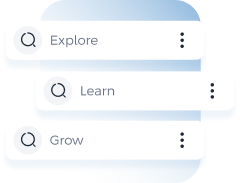
Refine Your Search
...
Explore Financial Academy
About the Academy
Discover our Rich, 60-Year Journey
Jadarat
A Comprehensive System for Skill and Knowledge Development
Governance
Meet our Inspiring Leadership
Success Stories
Check out our Clients’ Reviews and Testimonials


...


Discover the art of data analysis and interactive reporting using Power BI
Microsoft’s Power BI is one of the top data analysis and decision-making support tools, which provides deep insights of the organization’s core data through interactive dashboards and reports. This training program aims to provide participants with the skills to design scalable data models, filter and process data, create and improve reports, and manage workspaces.
Banking
Capital Market
Insurance
Financing
Artificial Intelligence and Data Management
Not Exist
Lecture
Case Studies +1
Lecture
Case Studies
Exercises and assignments
Pre Exam
Post Exam
All job families in the financial sector
This provides you with the opportunity to select the available times that suit you best for participation in our program. These times represent slots during which we are ready to welcome you and provide assistance and guidance.
In Class Training-Online Training
Identify and connect to a data source
Change data source settings
Select a shared dataset or create a local dataset
Select a storage mode
Choose an appropriate query type
Identify query performance issues
Use parameters
In Class Training-Online Training
Identify data anomalies
Examine data structures
Interrogate column properties
Interrogate data statistics
In Class Training-Online Training
Resolve inconsistencies, unexpected or null values, and data quality issues
Apply user-friendly value replacements
Identify and create appropriate keys for joins
Evaluate and transform column data types
Apply data shape transformations to table structures
Combine queries
Apply user-friendly naming conventions to columns and queries
Leverage Advanced Editor to modify Power Query M code
Configure data loading
Resolve data import errors
In Class Training-Online Training
Define the tables
Configure table and column properties
Define quick measures
Flatten out a parent-child hierarchy
Define role-playing dimensions
Define a relationship's cardinality and cross-filter direction
Design the data model to meet performance requirements
Resolve many-to-many relationships
Create a common date table
Define the appropriate level of data granularity
In Class Training-Online Training
Apply cross-filter direction and security filtering
Create calculated tables
Create hierarchies
Create calculated columns
Implement row-level security roles
Set up the Q
In Class Training-Online Training
Use DAX to build complex measures
Use CALCULATE to manipulate filters
Implement Time Intelligence using DAX
Replace numeric columns with measures
Use basic statistical functions to enhance data
Create semi-additive measures
In Class Training-Online Training
Remove unnecessary rows and columns
Identify poorly performing measures, relationships, and
Improve cardinality levels by changing data types
Improve cardinality levels through summarization
Create and manage aggregations
In Class Training-Online Training
Add visualization items to reports
Choose an appropriate visualization type
Format and configure visualizations
Import a custom visual
Configure conditional formatting
Apply slicing and filtering
Add an R or Python visual
Configure the report page
Design and configure for accessibility
Configure automatic page refresh
In Class Training-Online Training
Set mobile view
Manage tiles on a dashboard
Configure data alerts
Use the Q
Add a dashboard theme
Pin a live report page to a dashboard
Configure data classification
In Class Training-Online Training
Configure bookmarks
Create custom tooltips
Edit and configure interactions between visuals
Configure navigation for a report
Apply sorting
Configure Sync Slicers
Use the selection pane
Use drill through and cross filter
Drilldown into data using interactive visuals
Export report data
Design reports for mobile devices
In Class Training-Online Training
Apply conditional formatting
Apply slicers and filters
Perform top N analysis
Explore statistical summary
Use the Q
Add a Quick Insights result to a report
Create reference lines by using Analytics pane
Use the Play Axis feature of a visualization
In Class Training-Online Training
Identify outliers
Conduct Time Series analysis
Use groupings and bindings
Use the Key Influencers to explore dimensional variances
Use the decomposition tree visual to break down a measure
Apply AI Insights
In Class Training-Online Training
Manage datasets
Configure a dataset scheduled refresh
Configure row-level security group membership
Providing access to datasets
Configure incremental refresh settings
Promote or certify a dataset
In Class Training-Online Training
Create and configure a workspace
Recommend a development lifecycle strategy
Assign workspace roles
Configure and update a workspace app
Publish, import, or update assets in a workspace
Apply sensitivity labels to workspace content
Discuss the various methods and best practices that are in line with business and technical requirements for modeling, visualizing, and analyzing data with Power BI.
Access and process data from a range of data sources including both relational and non-relational data.
Implement proper security standards and policies across the Power BI spectrum including datasets and groups.
Manage and deploy reports and dashboards for sharing and content distribution.
Build paginated reports within the Power BI service and publish them to a workspace for inclusion within Power BI.
